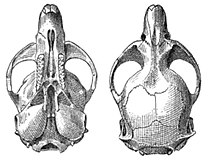Microtus oregoni
| Creeping vole | |
|---|---|
 |
|
| Scientific classification | |
| Kingdom: | Animalia |
| Phylum: | Chordata |
| Class: | Mammalia |
| Order: | Rodentia |
| Family: | Cricetidae |
| Genus: | Microtus |
| Subgenus: | Mynomes |
| Species: | M. oregoni |
| Binomial name | |
|
Microtus oregoni (Bachman, 1839) |
|
 |
|
| Distribution of the creeping vole | |
| Synonyms | |
|
List
|
|
The creeping vole (Microtus oregoni), sometimes known as the Oregon meadow mouse, is a small rodent in the family Cricetidae. Ranging across the Pacific Northwest of United States and Canada, it is found in forests, grasslands, woodlands, and chaparral environments. The small-tailed, furry, brownish-gray mammal was first described in the scientific literature in 1839, from a specimen collected near the mouth of the Columbia River. The smallest vole in its range, it weighs around 19 g (0.67 oz). At birth, they weigh 1.6 g (0.056 oz), are naked, pink, unable to open their eyes, and the ear flaps completely cover the ear openings. Although not always common throughout their range, there are no major concerns for their survival as a species.
The animal was described in 1839 by John Bachman. The original scientific name was Arvicola oregoni with a common name of the Oregon meadow mouse. The type specimen was an older male collected November 2, 1836 near the mouth of the Columbia River in Oregon. The specimen had been submitted to Bachman for review by John Kirk Townsend. Subsequent authorities state that it was collected at Astoria, Oregon, which is at the mouth of the Columbia River. In 1857, Baird placed Arvicola oregoni in a section Chilotus of the subgenus Arvicola of the genus Arvicola. In 1874, PNAS paper, Coues reclassified Chilotus as a subgenus and refers to the animal as Arvicola (Chilotus) oregonus. Miller subsequently reclassified the animal in the genus Microtus and maintained the subgenus Chilotus. This was the first reference to the animal under its current scientific name Microtus oregoni. It was subsequently reclassified to the subgenus Mynomes.
On average, creeping voles weigh around 19 g (0.67 oz) with a reported range of 14.5 to 27.5 g (0.51 to 0.97 oz) The average length is around 140 mm (5.5 in), with a range of around 129 to 154 mm (5.1 to 6.1 in) Compared to other voles within their geographic range, they are the smallest. They have smaller eye opening (around 2 mm (0.079 in) in diameter) compared to other voles that share the same geographic range (sympatric) or have adjacent ranges (parapatric). There are other distinguishing features of the roots and enamel of the molar teeth that help in differentiation. Unlike other voles in the range, only the creeping vole and the (much larger) water vole have five plantar tubercles on the hindfeet.
...
Wikipedia

